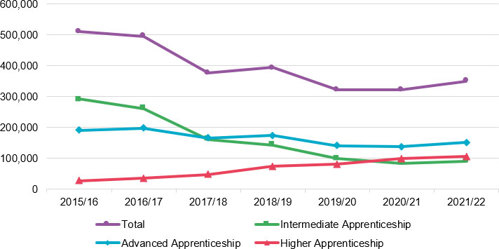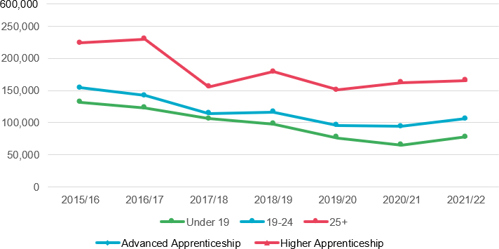Latest statistics show continued concerns for numbers of intermediate and advanced apprenticeships
Tuesday 6 June 2023
 This blog post was first published in FE Week on Friday 3rd February 2023.
This blog post was first published in FE Week on Friday 3rd February 2023.
Last week, the DfE published its latest statistics on the number of apprenticeships being started. These fell by 69 per cent between 2015/16 and 2021/22 - primarily due to reforms to the apprenticeship system coupled with disruption created by the Covid-19 pandemic. In this article, we examine what the latest data tells us about the extent of the recovery.
A bumpy ride…
The Government introduced a raft of reforms to the apprenticeship system in the last decade. These were aimed at addressing concerns about the quality, length and content of apprenticeships, and were intended to improve their responsiveness to employer needs. However, NFER research has shown that these reforms have had a substantial impact on the number of apprenticeships being started, particularly among young people.
This is illustrated in Figure 1, which shows total starts fell from 509,000 in 2015/16 to 393,000 in 2018/19. They then fell further to around 320,000 in the following two years, primarily due to the pandemic, before recovering in 2021/22 to 349,000.
However, this overall trend masks substantial differences between apprenticeship levels. Figure 1 shows that the pattern for intermediate (Level 2) and advanced (Level 3) apprenticeships starts have the same downward trend as for total starts. However, the story is different for higher (Level 4+) apprenticeships, which have grown sharply. There are almost four times as many higher apprenticeship starts than in 2015/16, albeit from a low base and they have now surpassed intermediate starts.
Figure 1: Apprenticeship starts 2015/16 to 2021/22

Source: DfE Apprenticeships and traineeships statistics
Has the post-pandemic bounce-back in apprenticeship starts continued?
In short, the initial evidence from DfE’s recent statistics is no. These statistics, which provide data about apprenticeship starts during the first quarter of the 2022/23 academic year (for August-October 2022, so not full year figures), show total starts were down by 6.1 per cent compared to the same period in the previous year. This may be a temporary blip as starts could pick up in the remaining quarters. However, one possible reason for the decline is the withdrawal of the £3,000 incentive payment scheme in March 2022 that the Government introduced during the pandemic to encourage employers to take on new apprentices.
The recent statistics also show starts vary significantly by type of apprenticeship. After strongly bouncing back post the pandemic, intermediate apprenticeship starts have been worst affected, falling by nearly a fifth (18.4 per cent) between Q1, 2022/23 and a year earlier. Advanced apprenticeships are also down by nearly a tenth (9.2 per cent) over the same time period. However, higher level start numbers march on, increasing by 10 per cent across the time period.
This data therefore suggests that apprenticeship starts are returning to the long-term trends seen before the post pandemic bounce-back, with intermediate and advanced apprenticeship starts are continuing their decline while higher level apprenticeships are flourishing. As highlighted in previous NFER research, the reasons for this are complex and multi-faceted. Potential solutions include looking at the current funding system, the qualification offering at the intermediate-level and improving access to apprenticeships.
What is happening to apprenticeship starts by age?
Figure 2 shows the longer-term trends in apprenticeship starts by age group. All age groups broadly follow the same decline trend seen in Figure 1 for total apprenticeship starts. The under 19s have been particularly affected, falling to half the level of 2015/16 starts in 2020/21, before recovering slightly.
Figure 2: Apprenticeship starts by age 2015/16 to 2021/22

Source: DfE Apprenticeships and traineeships statistics
Looking at DfE’s most recent statistics, these show that starts for the 19-24 year old group has fallen sharply by 11.4 percent between Q1, 2022/23 and the same point last year. Conversely, starts for under 19s have dropped by 4.1 per cent while the aged 25+ group fell by 3.5 per cent.
Concerns remain for equalising access for young people
These new statistics serve as a reminder that there are much needed improvements required, particularly for the recruitment of under 19s onto intermediate and advanced apprenticeships to ensure that there is a clear and effective pathway for young people to progress into higher-level training or employment.
